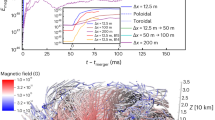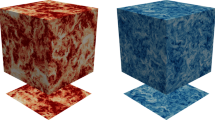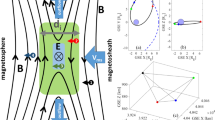Abstract
Magnetohydrodynamic turbulence is important in many high-energy astrophysical systems, where instabilities can amplify the local magnetic field over very short timescales1,2. Specifically, the magnetorotational instability and dynamo action3,4,5,6 have been suggested as a mechanism for the growth of magnetar-strength magnetic fields (of 1015 gauss and above) and for powering the explosion7,8,9,10 of a rotating massive star11,12. Such stars are candidate progenitors of type Ic-bl hypernovae13,14, which make up all supernovae that are connected to long γ-ray bursts15,16. The magnetorotational instability has been studied with local high-resolution shearing-box simulations in three dimensions17,18,19, and with global two-dimensional simulations20, but it is not known whether turbulence driven by this instability can result in the creation of a large-scale, ordered and dynamically relevant field. Here we report results from global, three-dimensional, general-relativistic magnetohydrodynamic turbulence simulations. We show that hydromagnetic turbulence in rapidly rotating protoneutron stars produces an inverse cascade of energy. We find a large-scale, ordered toroidal field that is consistent with the formation of bipolar magnetorotationally driven outflows. Our results demonstrate that rapidly rotating massive stars are plausible progenitors for both type Ic-bl supernovae13,21,22 and long γ-ray bursts, and provide a viable mechanism for the formation of magnetars23,24. Moreover, our findings suggest that rapidly rotating massive stars might lie behind potentially magnetar-powered superluminous supernovae25,26.
This is a preview of subscription content, access via your institution
Access options
Subscribe to this journal
Receive 51 print issues and online access
$199.00 per year
only $3.90 per issue
Buy this article
- Purchase on Springer Link
- Instant access to full article PDF
Prices may be subject to local taxes which are calculated during checkout




Similar content being viewed by others
References
Fricke, K. Stability of rotating stars II. The influence of toroidal and poloidal magnetic fields. Astron. Astrophys. 1, 388–398 (1969)
Balbus, S. A. & Hawley, J. F. A powerful local shear instability in weakly magnetized disks. I—linear analysis. II—nonlinear evolution. Astrophys. J. 376, 214–233 (1991)
Frisch, U., Pouquet, A., Leorat, J. & Mazure, A. Possibility of an inverse cascade of magnetic helicity in magnetohydrodynamic turbulence. J. Fluid Mech. 68, 769–778 (1975)
Moffatt, H. K. Magnetic Field Generation in Electrically Conducting Fluids. (Cambridge Univ. Press, 1978)
Brandenburg, A. & Subramanian, K. Astrophysical magnetic fields and nonlinear dynamo theory. Phys. Rep. 417, 1–209 (2005)
Brandenburg, A. The inverse cascade and nonlinear alpha-effect in simulations of isotropic helical hydromagnetic turbulence. Astrophys. J. 550, 824–840 (2001)
LeBlanc, J. M. & Wilson, J. R. A numerical example of the collapse of a rotating magnetized star. Astrophys. J. 161, 541–551 (1970)
Burrows, A., Dessart, L., Livne, E., Ott, C. D. & Murphy, J. Simulations of magnetically driven supernova and hypernova explosions in the context of rapid rotation. Astrophys. J. 664, 416–434 (2007)
Mösta, P. et al. Magnetorotational core-collapse supernovae in three dimensions. Astrophys. J. Lett. 785, L29 (2014)
Takiwaki, T. & Kotake, K. Gravitational wave signatures of magnetohydrodynamically driven core-collapse supernova explosions. Astrophys. J. 743, 30 (2011)
Akiyama, S., Wheeler, J. C., Meier, D. L. & Lichtenstadt, I. The magnetorotational instability in core-collapse supernova explosions. Astrophys. J. 584, 954–970 (2003)
Thompson, T. A., Quataert, E. & Burrows, A. Viscosity and rotation in core-collapse supernovae. Astrophys. J. 620, 861–877 (2005)
Drout, M. R. et al. The first systematic study of type Ibc supernova multi-band light curves. Astrophys. J. 741, 97 (2011)
Soderberg, A. M. et al. Relativistic ejecta from X-ray flash XRF 060218 and the rate of cosmic explosions. Nature 442, 1014–1017 (2006)
Hjorth, J. & Bloom, J. S. in Gamma-Ray Bursts (eds Wijers, R. A. M. J. & Woosley, S .) Ch. 9 (Cambridge Univ. Press, 2012)
Modjaz, M. Stellar forensics with the supernova-GRB connection. Astron. Nachr. 332, 434–447 (2011)
Obergaulinger, M., Cerdá-Durán, P., Müller, E. & Aloy, M. A. Semi-global simulations of the magneto-rotational instability in core collapse supernovae. Astron. Astrophys. 498, 241–271 (2009)
Masada, Y., Takiwaki, T. & Kotake, K. Magnetohydrodynamic turbulence powered by magnetorotational instability in nascent protoneutron stars. Astrophys. J. Lett. 798, L22 (2015)
Guilet, J., Müller, E. & Janka, H.-T. Neutrino viscosity and drag: impact on the magnetorotational instability in protoneutron stars. Mon. Not. R. Astron. Soc. 447, 3992–4003 (2015)
Sawai, H., Yamada, S. & Suzuki, H. Global simulations of magnetorotational instability in the collapsed core of a massive star. Astrophys. J. Lett. 770, L19 (2013)
Galama, T. J. et al. An unusual supernova in the error box of the γ-ray burst of 25 April 1998. Nature 395, 670–672 (1998)
Woosley, S. E. & Heger, A. The progenitor stars of gamma-ray bursts. Astrophys. J. 637, 914–921 (2006)
Thompson, C. & Duncan, R. C. Neutron star dynamos and the origins of pulsar magnetism. Astrophys. J. 408, 194–217 (1993)
Duncan, R. C. & Thompson, C. Formation of very strongly magnetized neutron stars—implications for gamma-ray bursts. Astrophys. J. Lett. 392, L9–L13 (1992)
Nicholl, M. et al. Slowly fading super-luminous supernovae that are not pair-instability explosions. Nature 502, 346–349 (2013)
Greiner, J. et al. A very luminous magnetar-powered supernova associated with an ultra-long γ-ray burst. Nature 523, 189–192 (2015)
Wheeler, J. C., Meier, D. L. & Wilson, J. R. Asymmetric supernovae from magnetocentrifugal jets. Astrophys. J. 568, 807–819 (2002)
Pessah, M. E. & Goodman, J. On the saturation of the magnetorotational instability via parasitic modes. Astrophys. J. Lett. 698, L72–L76 (2009)
Goodman, J. & Xu, G. Parasitic instabilities in magnetized, differentially rotating disks. Astrophys. J. 432, 213–223 (1994)
Ott, C. D., Burrows, A., Thompson, T. A., Livne, E. & Walder, R. The spin periods and rotational profiles of neutron stars at birth. Astrophys. J. (Suppl.) 164, 130–155 (2006)
Heger, A. & Langer, N. Presupernova evolution of rotating massive stars. II. Evolution of the surface properties. Astrophys. J. 544, 1016–1035 (2000)
Wheeler, J. C., Kagan, D. & Chatzopoulos, E. The role of the magnetorotational instability in massive stars. Astrophys. J. 799, 85 (2015)
Mösta, P. et al. GRHydro: a new open-source general-relativistic magnetohydrodynamics code for the Einstein toolkit. Class. Quantum Gravity 31, 015005 (2014)
Obergaulinger, M., Aloy, M. A. & Müller, E. Axisymmetric simulations of magneto-rotational core collapse: dynamics and gravitational wave signal. Astron. Astrophys. 450, 1107–1134 (2006)
Winteler, C. et al. Magnetorotationally driven supernovae as the origin of early galaxy r-process elements? Astrophys. J. Lett. 750, L22 (2012)
Nishimura, N., Takiwaki, T. & Thielemann, F.-K. The r-process nucleosynthesis in the various jet-like explosions of magnetorotational core-collapse supernovae. Astrophys. J. 810, 109 (2015)
Balbus, S. A. & Hawley, J. F. Instability, turbulence, and enhanced transport in accretion disks. Rev. Mod. Phys. 70, 1–53 (1998)
Löffler, F. et al. The Einstein toolkit: a community computational infrastructure for relativistic astrophysics. Class. Quantum Gravity 29, 115001 (2012)
Reisswig, C. et al. Three-dimensional general-relativistic hydrodynamic simulations of binary neutron star coalescence and stellar collapse with multipatch grids. Phys. Rev. D 87, 064023 (2013)
Tchekhovskoy, A., McKinney, J. C. & Narayan, R. WHAM: a WENO-based general relativistic numerical scheme. I. Hydrodynamics. Mon. Not. R. Astron. Soc. 379, 469–497 (2007)
Einfeldt, B. in Shock Tubes and Waves (ed. Groenig, H. ) 671–676 (VCH, 1988)
Tóth, G. The ∇ ⋅ B = 0 constraint in shock-capturing magnetohydrodynamics codes. J. Comput. Phys. 161, 605–652 (2000)
Lattimer, J. M. & Douglas Swesty, F. A generalized equation of state for hot, dense matter. Nucl. Phys. A 535, 331–376 (1991)
O’Connor, E. & Ott, C. D. A new open-source code for spherically symmetric stellar collapse to neutron stars and black holes. Class. Quantum Gravity 27, 4103 (2010)
Ott, C. D. et al. Correlated gravitational wave and neutrino signals from general-relativistic rapidly rotating iron core collapse. Phys. Rev. D 86, 024026 (2012)
Bogovalov, S. V. Boundary conditions and critical surfaces in astrophysical MHD winds. Astron. Astrophys. 323, 634–643 (1997)
Eswaran, V. & Pope, S. B. An examination of forcing in direct numerical simulations of turbulence. Comput. Fluids 16, 257–278 (1988)
Frisch, U. Turbulence. The Legacy of A. N. Kolmogorov (Cambridge Univ. Press, 1995)
Zrake, J. & MacFadyen, A. I. Magnetic energy production by turbulence in binary neutron star mergers. Astrophys. J. Lett. 769, L29 (2013)
Acknowledgements
We thank S. Couch, J. Zrake, D. Tsang, C. Wheeler, E. Bentivegna and I. Hinder for discussions. This research was supported by National Science Foundation (NSF) grants AST-1212170, PHY-1151197 and OCI-0905046; by NASA through the Einstein Fellowship Program, grants PF5-160140 (to P.M.) and PF3-140114 (to L.F.R.); by a National Science and Engineering Research Council of Canada (NSERC) award to E.S.; and by the Sherman Fairchild Foundation. The simulations were carried out on the NSF/National Center for Supercomputing Applications (NCSA) BlueWaters supercomputer (PRAC ACI-1440083).
Author information
Authors and Affiliations
Contributions
P.M. contributed to project planning and leadership, simulation code development, simulations, simulation analysis, visualization, interpretation of results and manuscript preparation. C.D.O. led the group, conceived the idea for the project, and contributed to project planning and leadership, interpretation and manuscript preparation. D.R. contributed to simulation analysis, interpretation, simulation code development and manuscript preparation. L.F.R. interpreted the results and reviewed the manuscript. E.S. contributed to simulation code development and manuscript review. R.H. contributed to development of the simulation code and visualization software, and reviewed the manuscript.
Corresponding author
Ethics declarations
Competing interests
The authors declare no competing financial interests.
Extended data figures and tables
Extended Data Figure 1 Evolution of the maximum poloidal magnetic field.
Both panels show the maximum poloidal magnetic field, Bp, as a function of time for the four resolutions: 500 m, 200 m, 100 m and 50 m. a, The global maximum field. b, The maximum field in a thin layer above and below the equatorial plane (−7.5 km ≤ z ≤ 7.5 km). The purple line indicates exponential growth with an exponential-folding time, τFGM, of 0.5 ms.
Extended Data Figure 2 Background flow stability analysis.
a, b, The stability criterion CMRI 20 ms after core bounce for the initial stellar collapse simulation. a, A two-dimensional x–y slice (z = 0) through the three-dimensional domain; b, an x–z slice (y = 0). Yellow and red indicate regions that are stable to shearing modes; dark blue and light blue indicate unstable regions. c, The wavelength, λFGM, of the FGM of the MRI. d, The growth time of the FGM, τFGM. Panels c and d are zoomed in on the shear layer around the protoneutron star.
Extended Data Figure 3 Angle-averaged poloidal magnetic current and magnetic flux.
All panels show r–z slices (cylindrical coordinates, angle-averaged in φ) of the poloidal magnetic current (Jpol, colour-coded) and superposed contours of magnetic flux (black lines) at t − tmap = 10.3 ms (final simulated time). a, The 500-m simulation; b, the 200-m simulation; c, the 100-m simulation; d, the 50-m simulation.
Extended Data Figure 4 Angle-averaged poloidal magnetic current and velocity vectors.
The figure shows r–z slices (cylindrical coordinates, angle-averaged in φ) of the poloidal magnetic current (Jpol, colour-coded) and superposed velocity vectors (red arrows) at t − tmap = 10.3 ms (final simulated time).
Extended Data Figure 5 AMR stellar collapse simulation.
All panels show profiles along the x direction of the initial stellar collapse simulation, 20 ms after core bounce. a, Density (ρ); b, entropy (s), kB is the Boltzmann constant; c, angular velocity (vang); d, fast magnetosonic speed (vfms).
Extended Data Figure 6 AMR stellar collapse simulation.
All panels show profiles along the z direction of the initial stellar collapse simulation, 20 ms after core bounce. a, Density; b, entropy; c, fast magnetosonic speed.
Extended Data Figure 7 Non-densitized turbulent kinetic and electromagnetic energy spectra.
a, A time series of non-densitized turbulent kinetic energy spectra, Ekin(k), compensated for Kolmogorov scaling (k−5/3), as a function of the dimensionless wavenumber k. b, A time series of non-densitized magnetic energy spectra, Emag(k), as a function of the dimensionless wavenumber k. In both panels, the initial spectrum at t − tmap = 0 ms (dashed black line) is shown for reference.
Rights and permissions
About this article
Cite this article
Mösta, P., Ott, C., Radice, D. et al. A large-scale dynamo and magnetoturbulence in rapidly rotating core-collapse supernovae. Nature 528, 376–379 (2015). https://doi.org/10.1038/nature15755
Received:
Accepted:
Published:
Issue Date:
DOI: https://doi.org/10.1038/nature15755
This article is cited by
-
Searches for continuous-wave gravitational radiation
Living Reviews in Relativity (2023)
-
On the role of magnetars-like magnetic fields into the dynamics and gravitational wave emission of binary neutron stars
General Relativity and Gravitation (2022)
-
Core-collapse supernova explosion theory
Nature (2021)
-
Relativistic fluid dynamics: physics for many different scales
Living Reviews in Relativity (2021)
-
Magnetic, thermal and rotational evolution of isolated neutron stars
Living Reviews in Computational Astrophysics (2019)
Comments
By submitting a comment you agree to abide by our Terms and Community Guidelines. If you find something abusive or that does not comply with our terms or guidelines please flag it as inappropriate.



